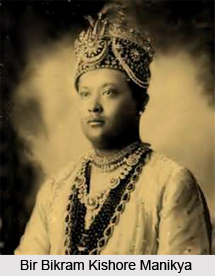 History of West Tripura District speaks about the development of the current-day district, right since the days of its inception and continuing over the period when Tripura was a princely state of India. The very last ruler of the region of Tripura was Bir Bikram Kishore Manikya and following his demise in May 1947, a regency under the supervision of his wife Maharani Kanchanpura Devi seized the reigns of administration of this area. She controlled the area on the behalf of Kirit Bikram Kishore Manikya, who was a minor prince and son of the deceased ruler of Bikram Kishore Manikya.
History of West Tripura District speaks about the development of the current-day district, right since the days of its inception and continuing over the period when Tripura was a princely state of India. The very last ruler of the region of Tripura was Bir Bikram Kishore Manikya and following his demise in May 1947, a regency under the supervision of his wife Maharani Kanchanpura Devi seized the reigns of administration of this area. She controlled the area on the behalf of Kirit Bikram Kishore Manikya, who was a minor prince and son of the deceased ruler of Bikram Kishore Manikya.
On 9th September, 1947 monarchy came to an abrupt conclusion. The Chief Commissioner gained control of Tripura and the region was administered as a Part C state. During 1st November, 1956, Tripura became a Union Territory of the nation, while on 15th August, 1959, the Territorial Council of Tripura came into existence. During the month of July in 1963 the Territorial Council dissolved and Legislative Assembly was formed. Eventually, in January 1972, Tripura was declared as an official State. A Collector and a District Magistrate controlled the district until 31st August, 1970. Tripura was soon divided into three different districts namely South Tripura, North Tripura and West Tripura District, in order to ensure better administration of this portion of the country and speeding up the progress of the area, particularly the tribal belts.
From 1st September, 1970, three Collectors and District Magistrates had been appointed to look after Tripura. There were as many as 10 sub-divisions of the one single District Territory. Sonamura, Sadar and Khowai are the various sub-divisions of West Tripura District. Kamalpur, Kailashahar and Dharmanagar are the sub divisions of North Tripura District while the sub divisions of the South Tripura District are Belonia, Udaipur, Sabroom and Amarpur. A portion of Athramura hill ranges and Baramura hills are amongst the six major hill ranges which are included within the boundaries of the district.
This article is a stub. You can enrich by adding more information to it. Send your Write Up to content@indianetzone.com






